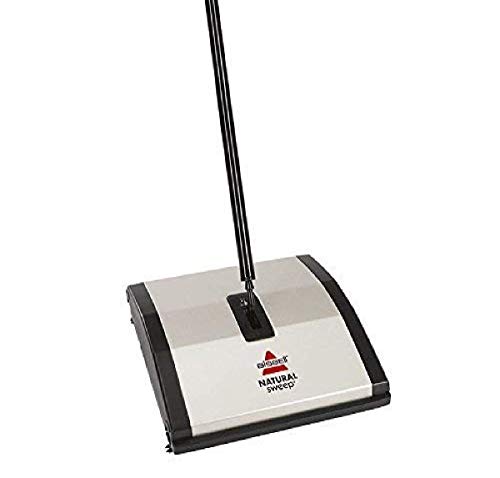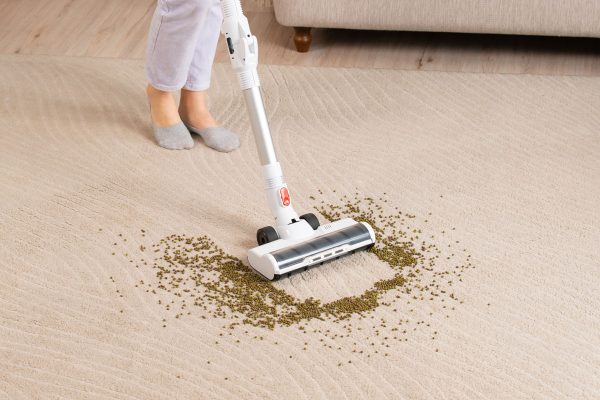A stair runner is essential to the stairs, especially if the flooring is a bit slippery. Perhaps you would like to install a stair runner but are keen on not using nails to secure it. If you are looking for nail alternatives for the installation, you have come to the right place. We researched ways to fix a stair runner without nails to help you out.
Using nails to secure stair runners will leave marks and damage your wood stairs. The following step-by-step guide is harmless and easy to execute to install your stair runners:
- Measure the width of the stairs and stair runners.
- Cut the stair runner.
- Dry fit the stair runner.
- Glue the stair runner.
- Apply pressure.
- Repeat steps four and five down the stairs.
This post will discuss each step in depth. We will also look into how to choose stair runners, as well as how to clean them. We encourage you to keep reading as we will equip you with more information about stairs and stair runners.
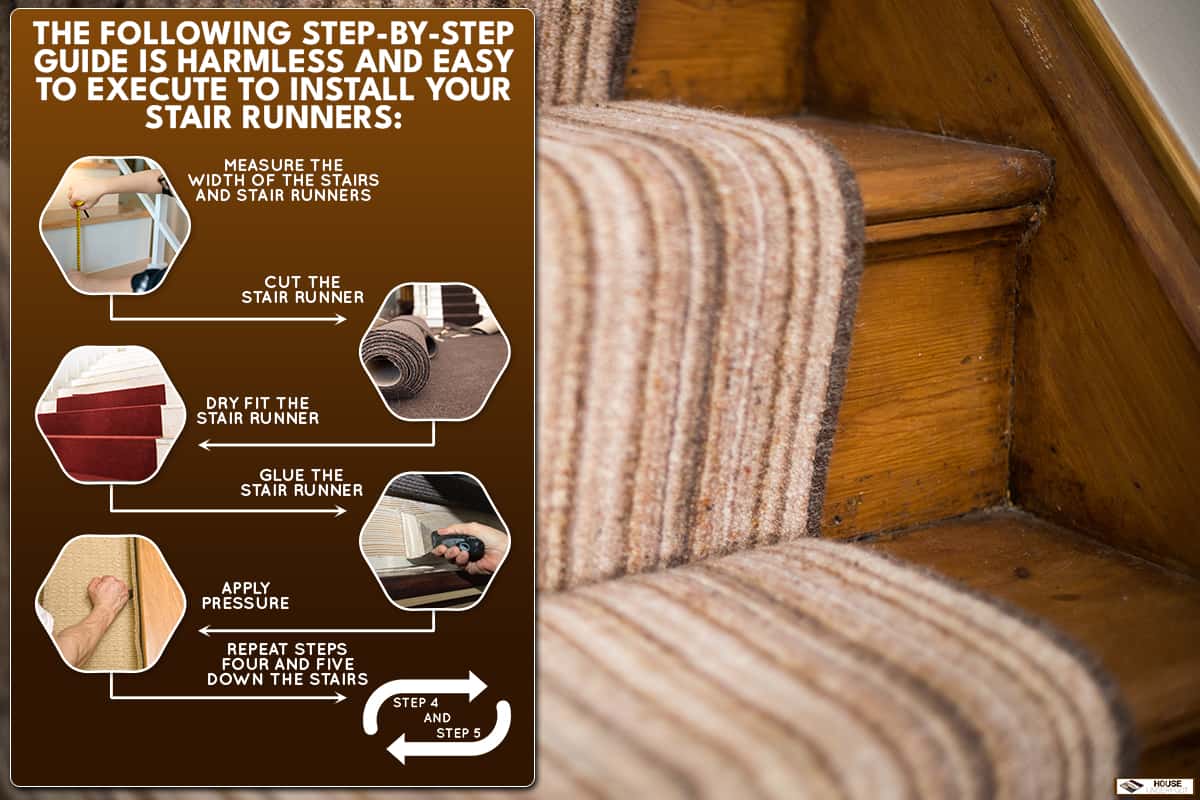
How to Install a Stair Runner Without Damaging the Stairs
Although nails can secure the stair runners, there are times when using them is not a good idea, such as when you are renting, and you want the stair runners to be temporary. You may also be reluctant to use nails because hammering them may damage the precious wood. Moreover, staples also leave marks on the stairs.
There's an alternative option to install stair runners without putting big holes in the stairs. We elaborate on this step-by-step guide below.
1. Measure The Width Of The Stairs And Stair Runners

First, find the stair's center. You want the runner to go to the middle to ensure that the stair runner will be even and wholly centered.
If you have a stair runner that's smaller than the width of the stairs, subtract the width of the stair runner from the stair's width, then divide the remainder by two. Measure this length from the edge of the stairs and use painter's tape to mark an inward point along the stairs. This point indicates where your runner should begin.
2. Cut The Stair Runner
You need to cut the stair runner if you choose a material that is bigger than the width of the stairs to ensure that it fits well.
3. Dry Fit The Stair Runner
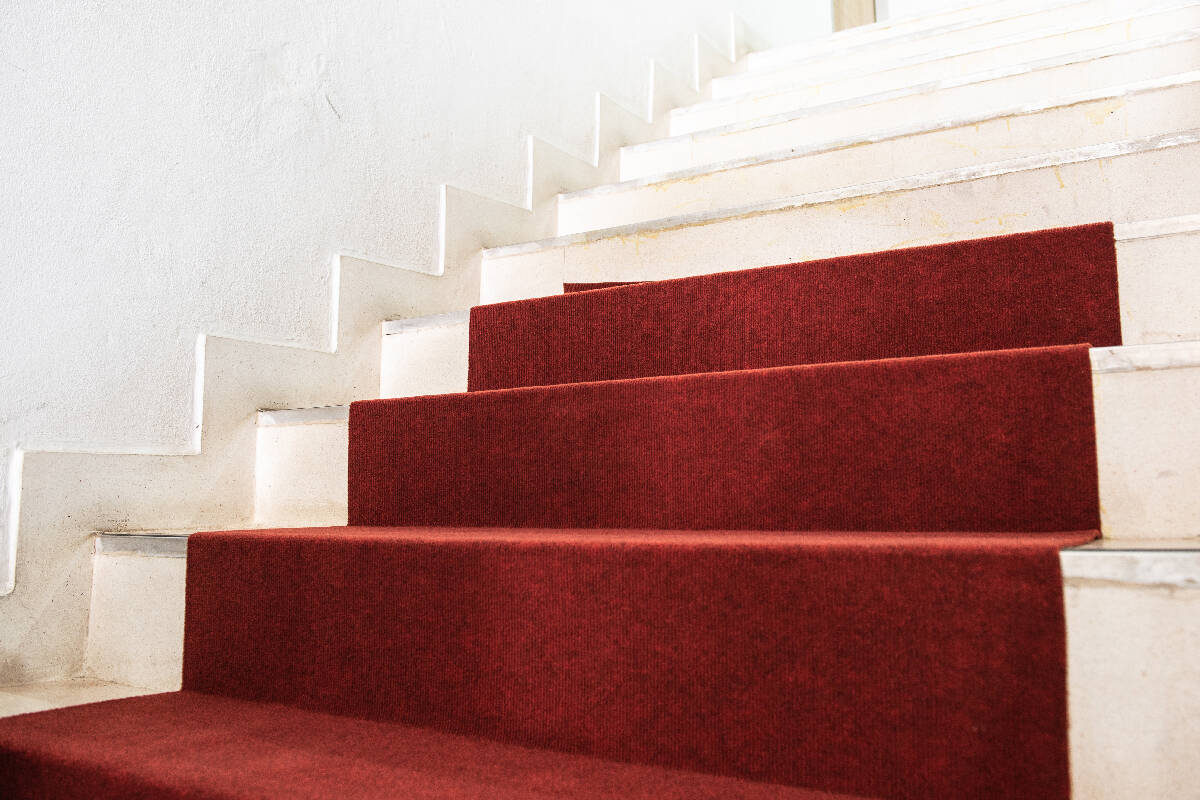
Before you secure the carpet or rug with glue, fit it first to ensure it is in the correct place. You may use tape for dry fitting. You won't be able to adjust it later when you glue it.
4. Glue The Stair Runner
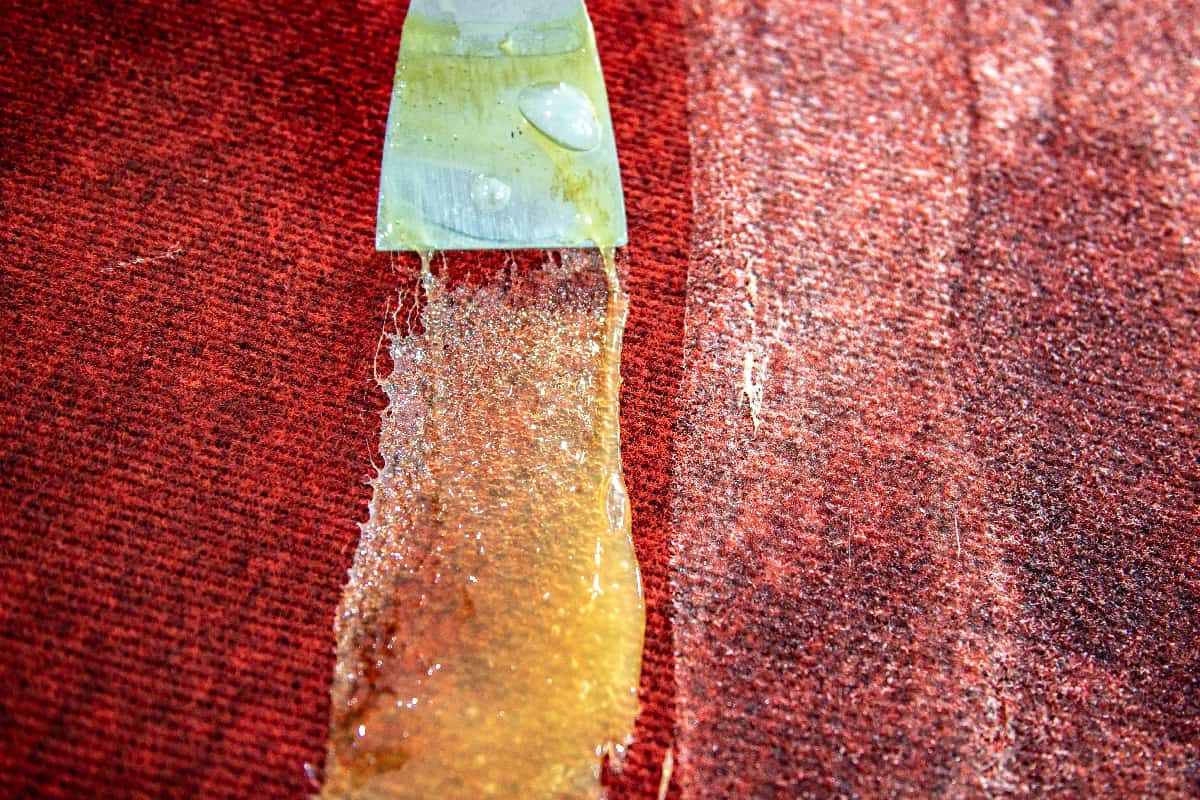
Make sure that the stairs are clean before proceeding. Wipe off any debris that will hinder the adhesive from doing its job.
Use a trowel or plastic scraper to spread the adhesive on the back of the carpet or rug. Please do not put too much as it'll go through the fibers of the runner.
Start sticking the stair runner from the first riser at the top of the stair.
What Adhesives Can You Use For Stair Runners?
You can choose from several adhesives in the market depending on your stairs. If your stairs are made of concrete, use a polyurethane adhesive since it is a strong adhesive that bonds carpets and concretes well.
Click here to see this polyurethane adhesive on Amazon.
If your stairs are made of wood, it is ideal to use a latex adhesive. This adhesive will stick properly and won't budge even if your stairs have high traffic. Lightly sand the wooden stairs before gluing the runner for better adhesion.
Click here to see this latex adhesive on Amazon.
5. Apply Pressure For Better Adhesion
You can use a wooden dowel to secure the stair runner firmly. Use carpet tuckers to push the stair runner between the stairs riser and tread.
Do not apply too much pressure to keep the glue from seeping through the fibers of the stair runners and avoid creating a mess.
Click here to see this carpet tucker on Amazon.
6. Repeat The Last Two Steps Until You Reach The Bottom Of The Stairs
Apply glue and tuck the stair runner on each step meticulously until you reach the bottom of the stairs. Make sure that the carpet or rug is attached firmly and that there are no loose ends that may make you trip.
What Can You Use As Stair Runners
If you find measuring and fitting rugs or carpets a bit of a nuisance, there are carpet stair treads you can use. These treads have self-sticking adhesive and are attached to the stair treads individually. Furthermore, these treads are also suitable for curved stairs because you install them one by one.
However, cleaning carpet stair treads may be more complex because stains are difficult to remove.
Click here to see this carpet stair tread on Amazon.
How To Choose The Right Runner For Your Stairs

You have decided that you need a stair runner. The ideal stair runner will depend on your needs and how much traffic the stairs get. So, how do you choose the right one for your home?
Get Samples
If you don't know what looks good on your stairs, bring samples home to test and see which one is suitable. But even if you have a design in mind, it is prudent to test it since the idea may not be ideal for your given conditions.
Consider The Pattern And Its Size
The carpet or rug's design carries the stairs' overall aesthetic. It brings simple wood stairs to life. However, it is best to avoid geometric patterns like squares and diamonds, where there is a need to match each piece precisely. It'll be pronounced if the patterns do not align, especially on straight stairs. So installing it will be hard.
Opt for abstract designs or patterns that do not require to be precisely matched. If you don't like patterns, you can always use neutral colors. As they say, you can't go wrong with neutrals.
Choose Quality
Your stair runner will probably take a lot of beating when you have kids or pets around the house. Even if you're thinking of stair runners as something temporary, choosing one that will last a long time is better.
Choose stair runners made of nylon or wool as they are durable and can withstand heavy traffic. Choosing a good quality stair runner is budget-friendly as you don't have to change them for quite some time.
How To Clean Stair Runners
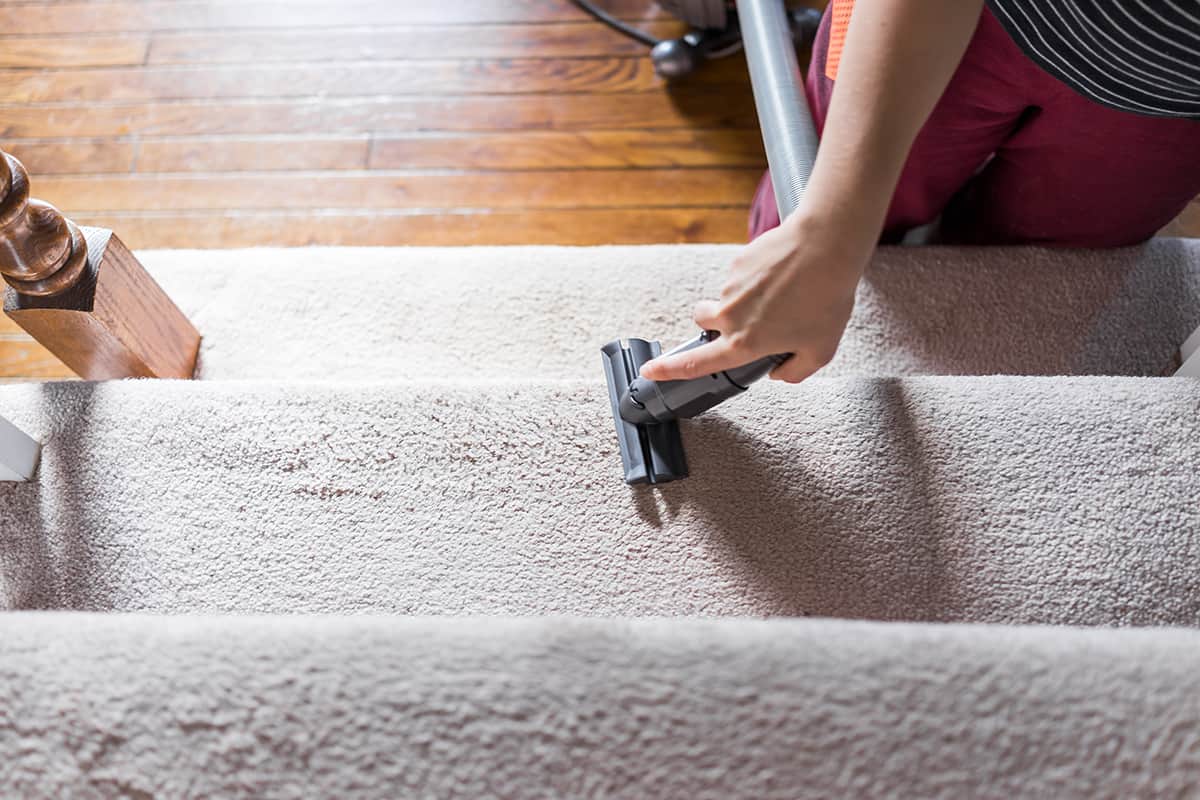
Cleaning stair runners is quite tasking. You should be meticulous when carrying out the exercise, even if the patterns of the runners hide dust.
Admittedly, vacuuming the stairs is doubly hard than vacuuming a room. However, it is good practice to vacuum the stair runners at least once a week. Canister vacuum cleaners are often a good choice for this job.
Click here to see this canister vacuum on Amazon.
If a vacuum is not handy, you can still use a plastic broom and a dustpan. These can remove dust effectively too.
Click here to see this broom on Amazon.
A carpet sweeper is also a viable alternative to vacuums.
Click here to see this carpet sweeper on Amazon.
How To Remove Glued Stair Runners?
We've already discussed how you can install a carpet runner without nails. But what do you do if it is time to move out and remove the stair runner, or maybe you've had a change of heart about having one? How do you ensure you won't leave marks on the stairs?
Using heavy-duty glue during installation implies that residues will be left in the wood or concrete. To minimize this, prepare the right tools for the job.
Pry a corner using a plier and pull out the stair runner. Do this while inspecting for glue residues. If you see glue remains, use a putty knife to scrape it off.
Please note that removing stair tread adhesives may be more tedious. Pour denatured alcohol on the adhesive and scrub until you see the dried adhesive lift off. Once done, wipe the stairs with a wet, soapy cloth to remove the alcohol residue, and then with a dry cloth.
If denatured alcohol doesn't work, you can use adhesive removers.
Click here to see this adhesive remover on Amazon.
Final Thoughts

Installing stair runners is especially beneficial when you have kids or pets, as they increase safety levels in your home. Furthermore, they contribute to home beautification and lessening noise.
You do not have to use nails to secure your stair runners; instead, you can opt for carpet adhesives. This alternative comes in handy, especially if you're worried about the damage to the stairs. The best part is you can easily install and remove these glued stair runners!
If you found this post helpful, check out these other articles:
Cleaning Carpet Under The Bed – A Complete 'How To' Guide
Difference Between Wall And Floor Tile Adhesive – Is There Any?







